Etude

China’s economic growth rate may have slowed, but the country continues to mint high-net-worth individuals (HNWIs) at a torrid pace. The number of Chinese with at least RMB 10 million (about US $1.5 million) in investable assets increased from approximately 180,000 in 2006 to nearly 1.6 million in 2016, representing a more than eightfold expansion within a decade. Among HNWIs, the ranks of the richest of the rich—those with at least RMB 100 million ($15 million) in investable assets—have grown at an even faster rate. There are now about 116,000 of these ultra-high-net-worth individuals (UHNWIs), compared with 7,000 in 2006 (see Figure 1).
All told, China’s private wealth has swelled to RMB 165 trillion (about $24 trillion), more than six times its level in 2006, according to the fifth China Private Wealth Report, developed by Bain & Company in collaboration with China Merchants Bank (CMB), a top-tier private banking brand in China and one of the country’s leading retail banks (see Figure 2). China’s ever-expanding pool of private wealth—roughly 40% of which is held in cash and bank deposits—is about twice the size of the country’s GDP and represents one of the fastest-growing accumulations of wealth in modern history.
Collectively, China’s HNWIs have about RMB 49 trillion (about $7 trillion) in investable assets, and they have grown more discerning about how, and with whom, they invest that money. Older wealthy individuals in China, who were the first generation to benefit from the government’s embrace of a market-based economy, were inclined to manage their money on their own, perhaps with some help from family and friends. By contrast, newer HNWIs—who often include the sons and daughters of first-generation company founders—are more willing to seek professional advice.
The explosive growth in the ranks of China’s HNWIs, combined with their increased willingness to consult professional financial services providers, creates tremendous opportunities for banks and other wealth managers, especially those that can fine-tune their offerings to the needs of individuals who are becoming increasingly internationally minded and technologically savvy. Successful financial services providers are also seeking ways to capitalize on a significant shift in the priorities of China’s wealthy. No longer narrowly focused on accumulating more wealth, HNWIs are becoming more concerned about preserving it—and passing it on to the next generation.
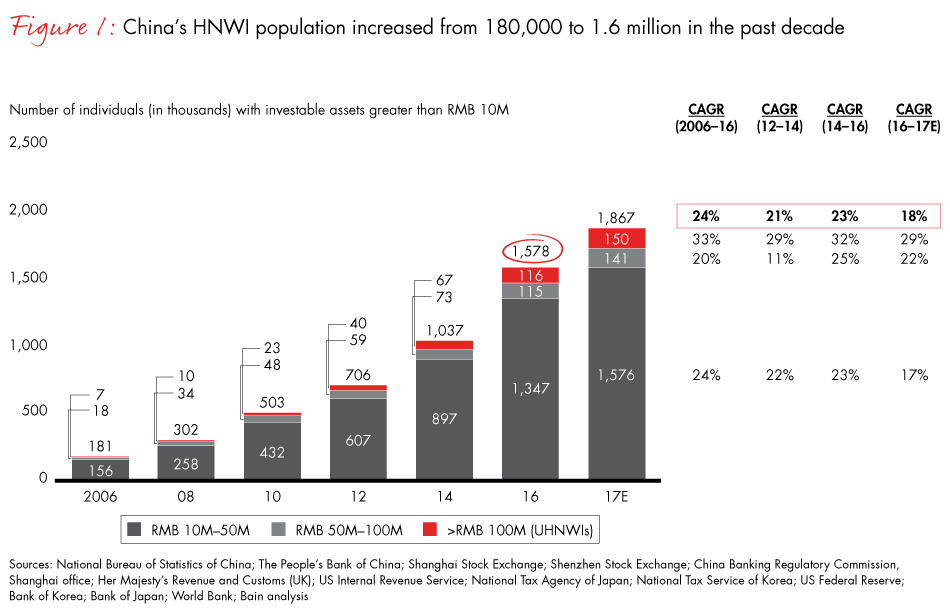
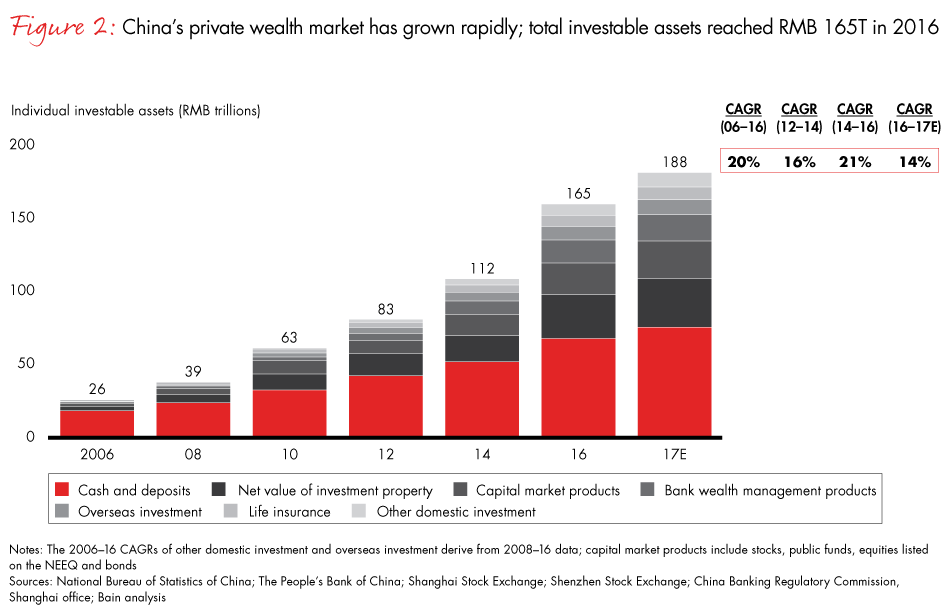
The four phases of China’s wealth boom
The past decade has brought a rapid accumulation of private wealth in China. Total private wealth has grown at a remarkable compound annual rate of 20%, and the number of HNWIs has expanded at an even faster annual pace of 24%. To gain insights into where China’s wealthy came from, where they live and where they’re headed, it’s helpful to view the current boom as a series of phases.
-
Phase I (2006–08). As private ownership of businesses increased and the economy soared, entrepreneurs in top-tier cities and coastal areas became rich, mostly by investing in their own enterprises.
In addition, they began recycling their profits from the real economy into capital markets and property to generate investment returns.
-
Phase II (2008–12). Partly in response to the global financial crisis, China’s central government took a series of steps to stimulate national economic growth and encourage wealth creation in underdeveloped regions. Government programs promoted industrial development in the Circum-Bohai-Sea region east of Beijing, as well as in central China.
-
Phase III (2012–14). Government initiatives spurred further wealth creation, particularly in southwest and central China. Beijing launched the One Belt, One Road (OBOR) program, which encourages trade between China and Eurasia along the route of the original Silk Road.
-
Phase IV (2014–present). A new round of growth is under way in top-tier cities and southeastern coastal areas, as high-tech enterprises blossom and traditional industries are upgraded and revitalized. The digital revolution has spawned a new class of wealthy individuals, including executives and other professionals. As China moves forward with OBOR, new wealth continues to be created, especially in the provinces most affected by the program.
The changing face of China’s HNWIs
As China’s wealthy grow richer and more numerous, they are also becoming more diverse, more dispersed and more differentiated in their goals and aspirations. From the outset, China’s private wealth boom has been fueled by business owners, especially in industries such as energy and manufacturing. While these first-generation company founders continue to make up the largest chunk of HNWIs, other categories of wealthy individuals are gaining ground. In 2009, first-generation business owners accounted for 70% of HNWIs; today, that share has shrunk to 41%. Many business owners have passed the baton to their adult children; second-generation successors now account for 10% of HNWIs.
As China’s original business founders age, a new generation of entrepreneurs is emerging, concentrated in technology-intensive industries. Some of these tech innovators have reaped financial windfalls by selling their companies to private bidders or by offering shares to the public.
With the rapid growth of Chinese companies, especially in the tech sector, private wealth has spread beyond business owners to an expanding class of well-paid executives, managers, engineers, accountants and other professionals—many of whom have also benefited from owning shares in their employers. These so-called gold-collar professionals constitute one of the fastest-growing cohorts of HNWIs. They tend to be young, urban and well educated, and they now account for 29% of China’s HNWIs, more than double their 12% share in 2009 (see Figure 3).
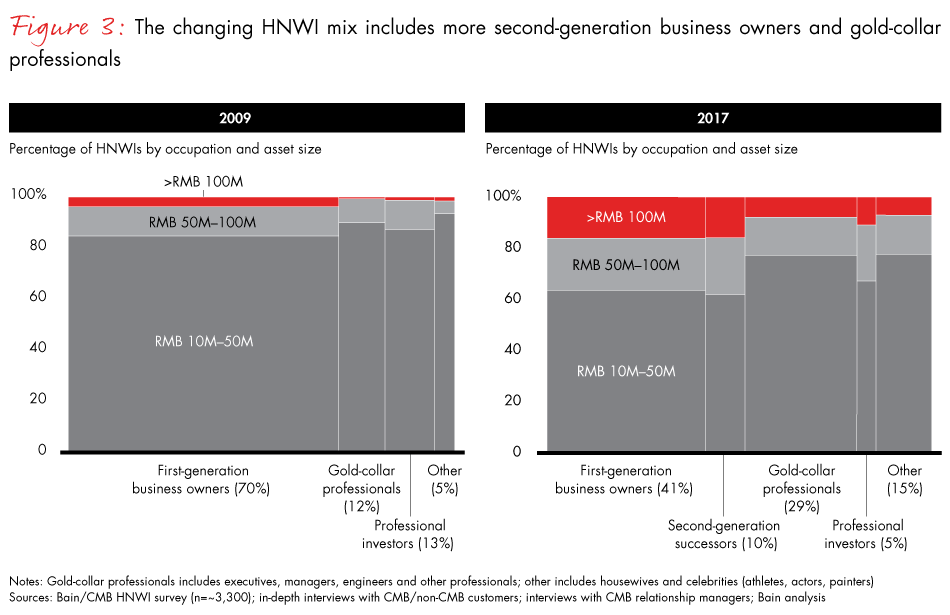
As the composition of China’s HNWIs has evolved, so has their geography. Once located almost exclusively in a few big cities and coastal provinces, the rich are now spread throughout the country. Of mainland China’s 25 provinces and municipalities, 22 have at least 20,000 HNWIs each, and 5 provinces and municipalities, all in the eastern part of the country, have more than 100,000 HNWIs each: Guangdong, Shanghai, Beijing, Jiangsu and Zhejiang. Ten years ago, Guangdong, located in the southeast, had 28,000 HNWIs; today, it has 193,000, nearly seven times as many.
A new emphasis on wealth preservation
A profound transformation is also occurring in the way China’s affluent view wealth itself. More and more, Chinese HNWIs regard money not just as a source of material well-being and social status but as something to be sustained and passed on to their descendants. In 2009, 37% of HNWIs ranked “wealth creation” as their top priority from a list of seven objectives, according to an ongoing survey of Chinese HNWIs by Bain and CMB. Today, 44% cite “wealth preservation” or “wealth inheritance” as their top priorities, compared with just 13% who pick “wealth creation.” The numbers are similar with UHNWIs: 45% favor “wealth preservation” or “wealth inheritance,” while 12% target “wealth creation” (see Figure 4).
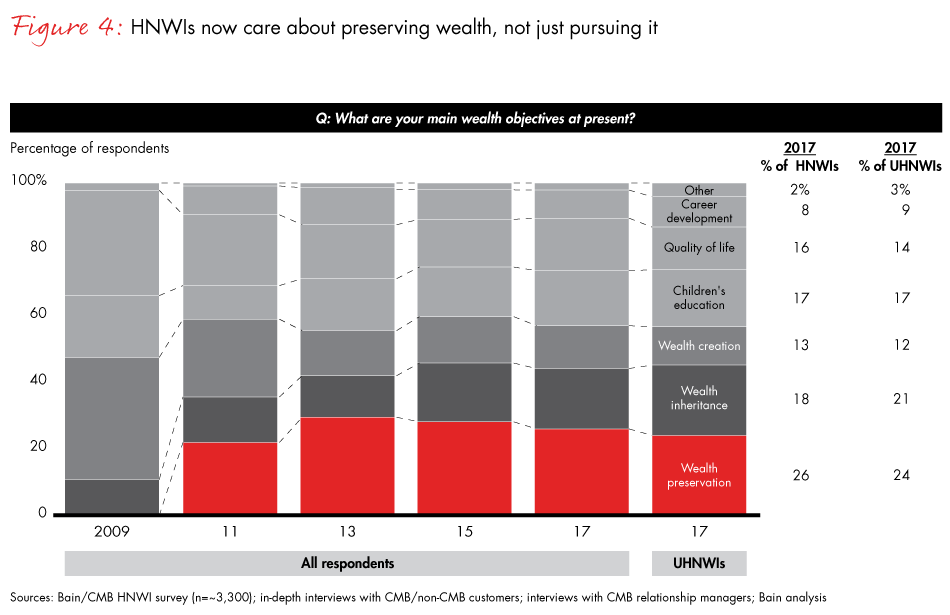
Company owners have begun to think seriously about family governance, business succession and estate planning—spurring demand for financial services providers that can assist in these areas. According to our survey, HNWIs consider wealth preservation their top priority, followed by asset allocation management, tax planning and legal consultation, and arrangements for the management of the business. UHNWIs in particular cite a pressing need for business inheritance planning, as they often run substantial companies.
Interestingly, although more than 80% of China’s family enterprises are still controlled by the first generation, only about 20% of ultra-high-net-worth business owners have already developed an inheritance plan. But some 55% say they are doing so now or plan to do so within the next three years. Their top priority is to set up shareholding structures that preserve family ownership, often in the form of trusts.

Inside China's Private Wealth Boom
A new generation of wealthy Chinese provides opportunities—and challenges—for financial services firms.
While ultra-high-net-worth business owners clearly want to provide for their children, they are open-minded about who will run their businesses when they are no longer at the helm. Some 60% say they are willing to hire capable professional executives from outside the family, and many are prepared to give those managers shares or dividend rights as incentives. However, even with these kinds of concessions to nonfamily executives, most UHNWIs want their enterprises to remain under family control, if not necessarily under family management.
Many wealthy business owners have also expressed increased interest in leveraging family office services. While the use of family offices is still very limited in China, about 40% of UHNWIs would consider using a family office for asset allocation, wealth preservation and inheritance, and tax, legal and business inheritance planning. Among the entire HNWI population, 52% say a family office can provide valuable planning and investment advice, but 54% say it’s important that the family, not the family office, retain control of decision making.
Where the wealthy are putting their money
Shifting wealth priorities are also reflected in the changing risk-return profiles of HNWIs. In 2009, 20% of HNWIs preferred a high-risk/high-return strategy. That percentage has fallen steadily since then, as wealthy individuals have seen what can happen to their investments in volatile markets. Today, only about 6% of HNWIs prefer a high-risk approach, and about 30% favor a low-risk/low-return strategy.
Now that their risk-return profiles are more balanced, HNWIs are ready to consider investing in other asset classes. While they still glean the bulk of their returns from their own companies, in the form of revenues, dividends and increases in market value, they’ve become more willing to invest in equities, bonds, real estate and other assets. HNWIs are also more inclined to look abroad for investment opportunities, and they’re more apt to consider alternative investments, including private equity, gold and hedge funds.
A steadily increasing number of Chinese HNWIs are investing overseas. In 2011, just 19% of HNWIs surveyed had investments outside the country. Today, 56% do. At the same time, since 2013, the proportion of their total portfolios invested overseas has stayed fairly constant, at about 25%. Among HNWIs who invest overseas, 82% say they do so to diversify investment risk, and 51% say they do so to seek investment opportunities globally. HNWIs who invest overseas hold most of those assets—about 60%—in cash, stocks or bonds. In the next one to two years, they expect to allocate greater portions of their overseas holdings to insurance, investment property and stocks.
Chinese HNWIs who invest overseas continue to diversify their investment destinations. Topping the list are Hong Kong and the US, although the share of HNWIs favoring those two markets has fallen since 2015. Rounding out the top five are Australia, Canada and Singapore, all of which have gained in investor preference since 2015 (see Figure 5).
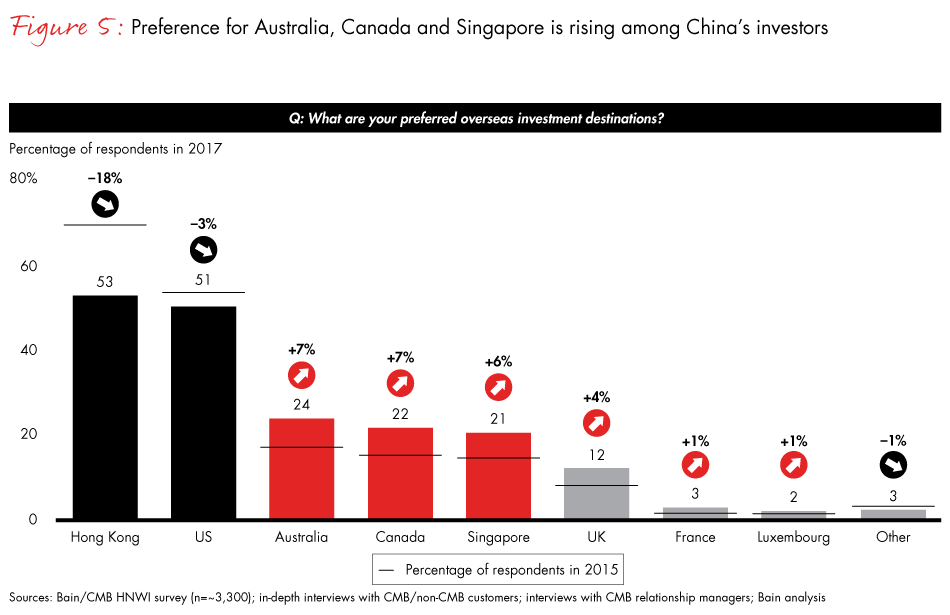
Looking forward, HNWIs expect to increase their allocations to insurance products and private equity funds in the next one to two years. Most wealthy individuals who’ve invested in PE funds in the past two years have made money; 77% reported positive returns, with 34% recording gains of at least 10%. A majority of HNWIs who invest in PE rely on private banks or other wealth management institutions to give them advice.
How financial advisers can serve China’s HNWIs
As recently as 2009, just 36% of wealthy Chinese used financial services providers, according to the Bain/CMB survey. Since then, practices have changed markedly. Today, 63% of China’s wealthy rely on financial services providers to manage their domestic financial assets, and among that group, more than half use private banking services offered by commercial banks (see Figure 6).
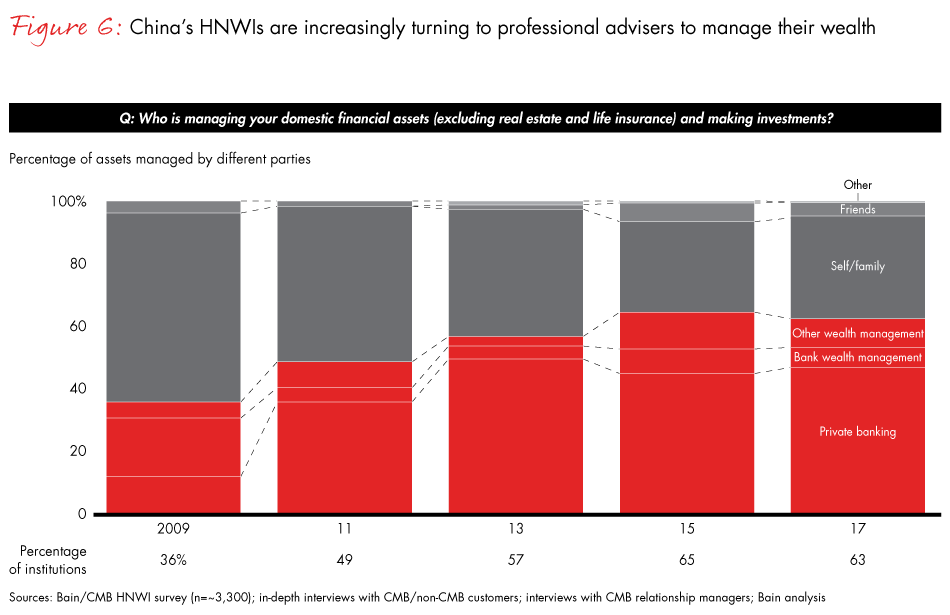
Financial services providers in China have been running hard to keep pace with the evolving and expanding needs of HNWIs. A decade ago, Chinese and foreign banks crowded into the wealth management market, eager to win the business of HNWIs, many of whom had never before used a wealth manager. In 2009, wealthy Chinese split their patronage fairly evenly among state-owned domestic banks, joint-stock commercial banks and foreign banks.
In recent years, though, joint-stock commercial banks have sharpened their focus on wealth management, steadily gaining ground on state-owned banks, as well as on foreign banks (see Figure 7). At the same time, nonbank financial institutions, such as fund management companies, securities companies and third-party wealth managers, have started to play a larger role.
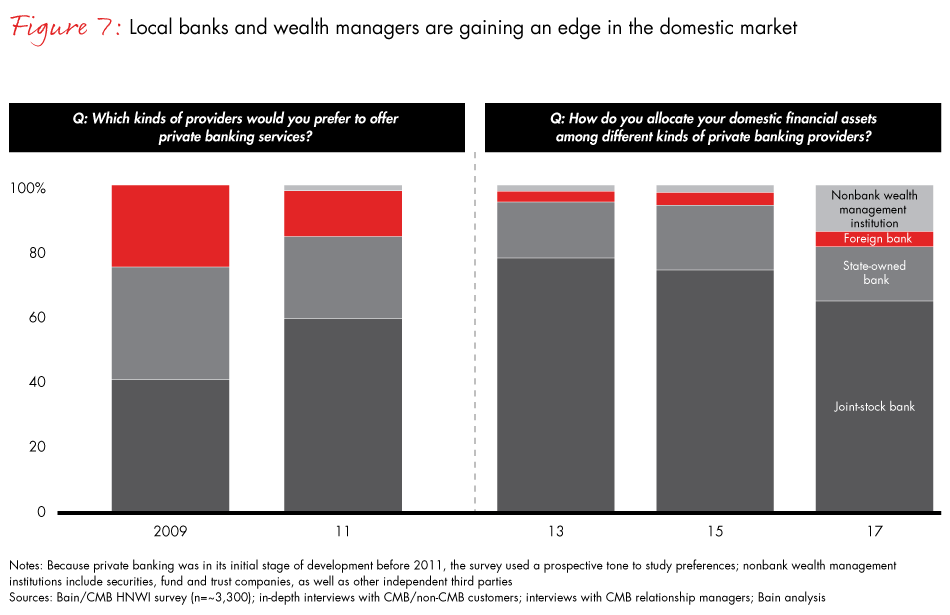
Chinese banks have stepped up their private banking activities, often gaining customers for wealth management who were already using the bank for other services. In addition to providing traditional wealth management services, private banks have expanded into customized solutions such as fee-based discretionary accounts. As business owners have become focused on inheritance, more private banks are offering family office services.
When picking wealth managers, HNWIs value the institution’s reputation above all else. Among those surveyed, 61% ranked “brand and trust” as the most important criterion, while 58% selected “expertise.” Chinese banks, with their long presence in the market and deep knowledge of their customers, have a home-court advantage when it comes to overseeing the domestic assets of high-net-worth clients.
But the same is not the case outside of China. When Chinese HNWIs seek out financial managers for their foreign investments, more than 60% pick a non-Chinese bank or other financial institution. Chinese banks, eager to capture more of this business, are following their customers’ money, setting up branches and hiring talent in major foreign markets.
Both Chinese and non-Chinese banks are learning the importance of being able to serve wealthy customers, particularly younger customers, with a high-tech as well as a high-touch approach. While HNWIs expect personalized service, they like the idea of receiving some information by email, text and teleconference. As innovative fintech firms move aggressively into the wealth management market in China, they are raising the bar on the speed and quality of the digital services HNWIs demand from their advisers.
To best profit from the growth and sophistication of China’s HNWIs, financial advisers should identify a market segment that plays to their strengths and develop products tailor-made to serve those customers. Successful managers are likely to be those that build a differentiated competition model and avoid an all-inclusive strategy that tries to serve a broad spectrum of wealthy customers. Different approaches will work for different kinds of firms.
-
Private banking units of commercial banks can continue to focus on wealth management for HNWIs and UHNWIs by offering comprehensive services, from investment advice to financing, including long-term wealth preservation and inheritance strategies.
-
Nonbank wealth managers can target affluent individuals with superior products and marketing while also providing a few high-end clients with customized financial advisory services.
-
Third-party wealth management platforms can serve the affluent and mass affluent with versatile and convenient products. These firms should continuously work on enhancing their risk management capabilities.
All wealth managers, regardless of their size or scope, need to make digitalization a high priority. Digital competence is critical to improving the efficiency and flexibility with which firms respond to their clients. Even when financial advisers are interacting with their customers in person or by telephone, they need the latest digital tools to help them do their jobs effectively.
When it comes to serving China’s increasingly internationally minded HNWIs, both Chinese and foreign financial advisers face challenges. Chinese banks can leverage their long-term client relationships and in-depth understanding of HNWIs to expand into the most popular overseas regions. They can also further develop their capabilities and expertise in these markets. Foreign wealth management firms, even those with powerful global reputations, need to work to overcome cultural and language barriers, develop products specifically tailored for Chinese HNWIs, build dedicated relationship managers and commit to continuously improving the client experience.
The future: New wealth, new opportunities
The forces that set in motion a decade of extraordinary private wealth creation in China look poised to continue. A new wave of entrepreneurs has brought high-tech innovation to the country’s vast market, spawning new industries and new fortunes. At the same time, leaders in traditional industries continue to upgrade and expand their businesses. All this activity will likely mean more IPOs, more mergers and acquisitions—and more wealth creation. The government will likely do its part to keep the money machine humming with business-friendly policies in designated regions.
As the population of HNWIs grows, it will become more diversified, with greater proportions of new-economy entrepreneurs and second-generation business owners. As enterprises expand and the capital markets grow, companies will look increasingly for professional managers, suggesting that the ranks of gold-collar HNWIs will continue to grow as well.
The ways in which Chinese HNWIs approach wealth have changed markedly during the past decade. A continued shift in priorities is likely, evolving from a focus on wealth accumulation to an emphasis on wealth preservation and inheritance, along with all the implications that holds for estate planning, family governance and business succession. As the desires of China’s HNWIs become more complex, their willingness to seek advice is growing—creating opportunities for financial services providers that are adroit enough to serve their evolving needs.
Jennifer Zeng and John Ott are partners in Bain & Company’s Financial Services practice, based, respectively, in Beijing and Shanghai.
Bain’s 2017 China Private Wealth Report was prepared in collaboration with China Merchants Bank. The authors would like to acknowledge the contributions of Xin Liu, a principal based in Bain’s Shanghai office.






